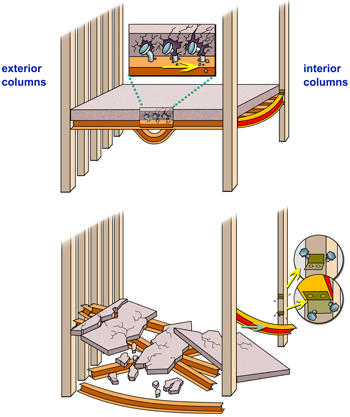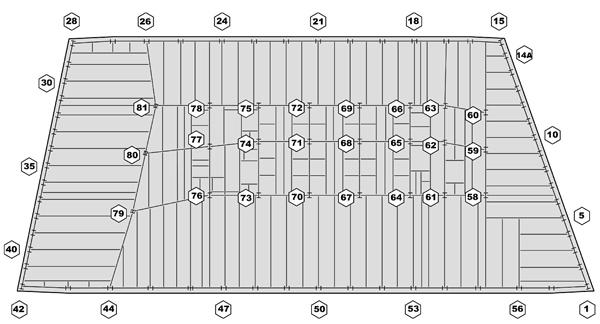NIST WTC 7 Investigation Finds Building Fires Caused Collapse
Report and Recommendations for Improving Building Safety Released for Comment

This graphic shows how thermal expansion led to the collapse of World Trade Center Building 7 (WTC 7). Heat from fires expanded steel beams on the east side of WTC 7, damaging the framing on multiple floors (top drawing). Eventually, a girder on Floor 13 lost its connection to a critical column, Column 79, and caused Floor 13 to collapse (bottom drawing). The cascade of floor failures that followed left Column 79 unsupported. When Column 79 buckled, it initiated the global collapse of the building.
"Our study found that the fires in WTC 7, which were uncontrolled but otherwise similar to fires experienced in other tall buildings, caused an extraordinary event," said NIST WTC Lead Investigator Shyam Sunder. "Heating of floor beams and girders caused a critical support column to fail, initiating a fire-induced progressive collapse that brought the building down."
"Video and photographic evidence combined with detailed computer simulations show that neither explosives nor fuel oil fires played a role in the collapse of WTC 7," Sunder said. The NIST investigation team also determined that other elements of the building's construction—namely trusses, girders and cantilever overhangs that were used to transfer loads from the building superstructure to the columns of the electric substation (over which WTC 7 was constructed) and foundation below—did not play a significant role in the collapse.
According to the report, a key factor leading to the eventual collapse of WTC 7 was thermal expansion of long-span floor systems at temperatures "hundreds of degrees below those typically considered in current practice for fire resistance ratings." WTC 7 used a structural system design in widespread use.
Citing its one new recommendation (the other 12 are reiterated from the previously completed investigation of the World Trade Center towers, WTC 1 and 2), the NIST investigation team said that "while the partial or total collapse of a tall building due to fires is a rare event, we strongly urge building owners, operators and designers to evaluate buildings to ensure the adequate fire performance of the structural system. Of particular concern are the effects of thermal expansion in buildings with one or more of the following features: long-span floor systems, connections not designed for thermal effects, asymmetric floor framing and/or composite floor systems." Engineers, the team said, should be able to design cost-effective fixes to address any areas of concern identified by such evaluations.
The investigators also reported that if the city water main had not been cut by the collapse of World Trade Center towers 1 and 2 (WTC 1 and WTC 2), operating sprinklers in WTC 7 would likely have prevented its collapse. "Nevertheless," Sunder said, "we recommend that building standards and codes be strengthened beyond their current intent to achieve life safety by preventing structural collapse even during severe fires like this one, when sprinklers do not function, do not exist or are overwhelmed by fire."
Sunder identified several existing, emerging or even anticipated capabilities that could have helped prevent WTC 7's collapse. He cautioned that the degree to which these capabilities improve performance remains to be evaluated. Possible options for developing cost-effective fixes include:
- More robust connections and framing systems to better resist effects of thermal expansion on the structural system.
- Structural systems expressly designed to prevent progressive collapse, which is the spread of local damage from a single initiating event, from element to element, eventually resulting in the collapse of an entire structure or a disproportionately large part of it. Current model building codes do not require that buildings be designed to resist progressive collapse.
- Better thermal insulation (i.e., reduced conductivity and/or increased thickness) to limit heating of structural steel and to minimize both thermal expansion and weakening effects. Insulation has been used to protect steel strength, but it could be used to maintain a lower temperature in the steel framing to limit thermal expansion.
- Improved compartmentation in tenant areas to limit the spread of fires.
- Thermally resistant window assemblies to limit breakage, reduce air supply and retard fire growth.
The 12 recommendations reiterated from the WTC towers investigation address several areas, including specific improvements to building standards, codes and practices; changes to, or the establishment of, evacuation and emergency response procedures; and research and other appropriate actions needed to help prevent future building failures.
Determining the probable collapse sequence for WTC 7, NIST found that the impact of debris from the collapse of WTC 1 ignited fires on at least 10 floors of WTC 7, and the fires burned out of control on six lower floors. The heat from these uncontrolled fires caused thermal expansion of the steel beams on the lower floors of the east side of WTC 7, damaging the floor framing on multiple floors. Eventually, a girder on Floor 13 lost its connection to a critical interior column that provided support for the long floor spans on the east side of the building. The displaced girder and other local fire-induced damage caused Floor 13 to collapse, beginning a cascade of floor failures down to the fifth floor. Many of these floors had already been at least partially weakened by the fires in the vicinity of the critical column. This collapse of floors left the critical column unsupported over nine stories.
"When this critical column buckled due to lack of floor supports, it was the first domino in the chain," Sunder explained. "What followed in rapid succession was a progression of structural failures. Failure first occurred all the way to the roof line—involving all three interior columns on the most eastern side of the building. Then, progressing from east to west across WTC 7, all of the columns in the core of the building failed. Finally, the entire façade collapsed."

The investigation team considered the possibility of other factors playing a role in the collapse of WTC 7, including the possible use of explosives, fires fed by the fuel supply tanks in and under the building, and damage from the falling debris of WTC 1.
The team said that the smallest blast event capable of crippling the critical column would have produced a "sound level of 130 to 140 decibels at a distance of half a mile," yet no noise this loud was reported by witnesses or recorded on videos.
As for fuel fires, the team found that they could not have been sustained long enough, could not have generated sufficient heat to fail a critical column, and/or would have produced "large amounts of visible smoke" from Floors 5 and 6, which was not observed.
Finally, the report notes that "while debris impact from the collapse of WTC 1 initiated fires in WTC 7, the resulting structural damage had little effect in causing the collapse of WTC 7."
The investigation team found that the design of WTC 7 was generally consistent with the New York City building code in effect at the time. The estimated 4,000 occupants of WTC 7 on the morning of Sept. 11 were evacuated without any fatalities or serious injuries.
To reach the conclusions in its report, NIST complemented its in-house expertise with private-sector technical experts; accumulated an extensive collection of documents, photographs and videos related to the WTC events of 9/11; conducted first-person interviews of WTC 7 occupants and emergency responders; analyzed the evacuation and emergency response operations in and around WTC 7; and performed the most complex computer simulations ever conducted to model a building's response behavior and determine its collapse sequence due to a combination of debris impact damage, fires and a progression of structural failures from local fire-induced damage to collapse initiation, and, ultimately, to global collapse.
NIST welcomes comments on the draft report and recommendations—available online at http://wtc.nist.gov—received by noon Eastern Daylight Time on Sept.15, 2008. Comments (instructions for submission are available at http://wtc.nist.gov) may be submitted via:
- e-mail to wtc [at] nist.gov (wtc[at]nist[dot]gov);
- fax to (301) 869-6275; or
- surface mail to WTC Technical Information Repository, Attn: Stephen Cauffman, NIST, 100 Bureau Dr., Stop 8611, Gaithersburg, Md. 20899-8610.
The NIST investigation of WTC 7 was conducted under the National Construction Safety Team (NCST) Act, as part of its overall building and fire safety investigation of the World Trade Center disaster. The act gives NIST the responsibility for conducting fact-finding investigations of building failures that resulted in substantial loss of life or that posed significant potential of substantial loss of life. NIST has no regulatory authority under the NCST Act.
As an agency of the U.S. Department of Commerce, NIST promotes U.S. innovation and industrial competitiveness by advancing measurement science, standards and technology in ways that enhance economic security and improve our quality of life.

